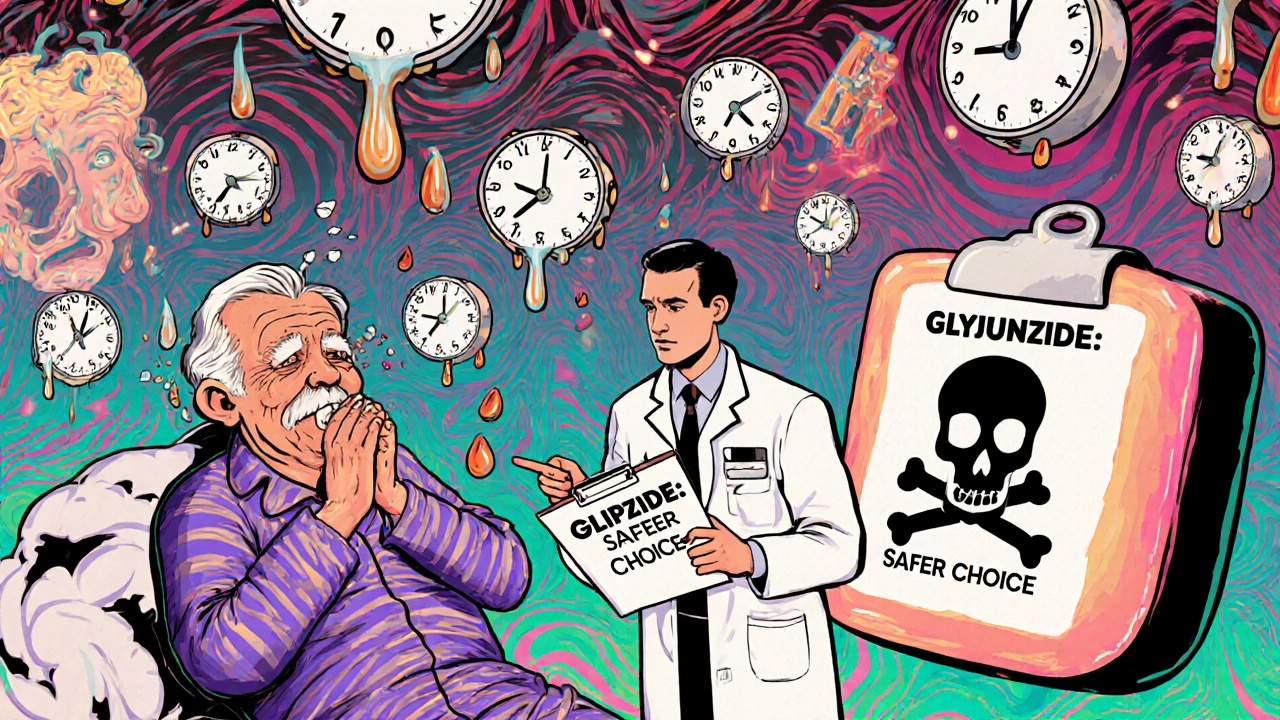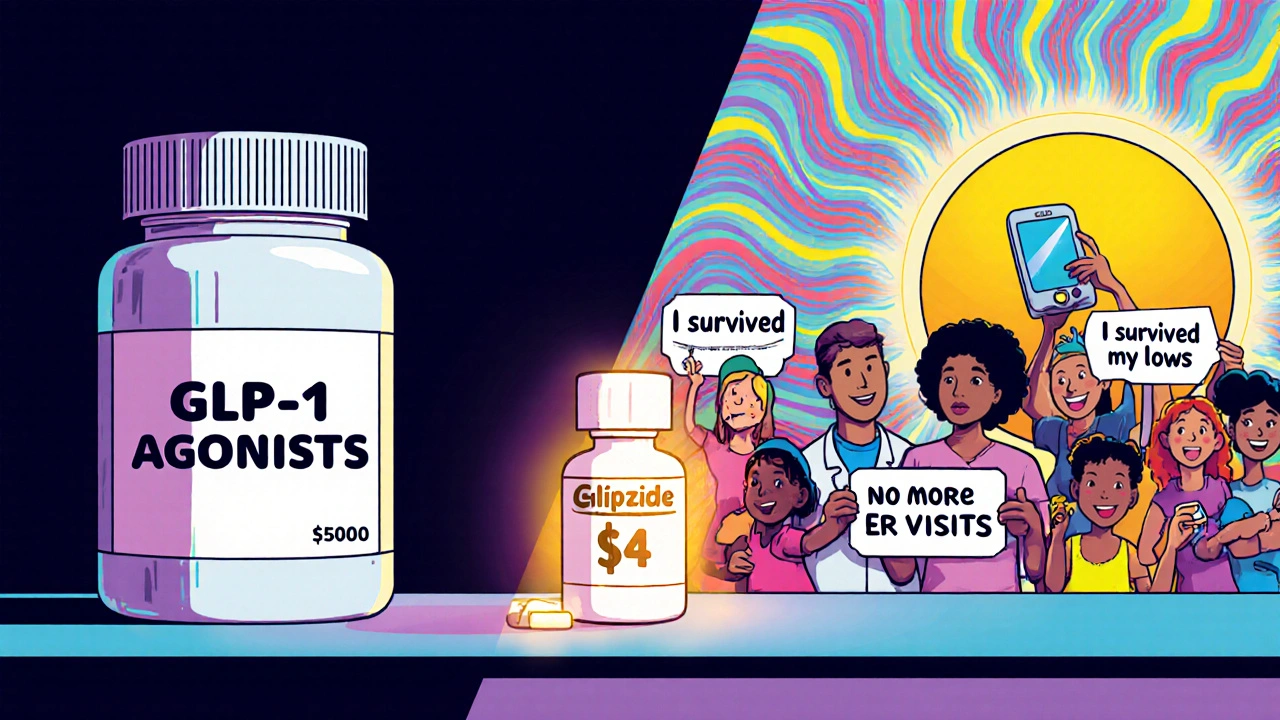Choosing a Sulfonylurea: Side Effect Differences and Hypoglycemia Risk

Sulfonylurea Hypoglycemia Risk Calculator
Risk Assessment
This tool calculates your relative risk of severe hypoglycemia based on your medication choice and medical factors.
When you're managing type 2 diabetes, picking the right medication isn't just about lowering blood sugar-it's about staying safe. Among the oldest and cheapest oral drugs available, sulfonylureas still play a major role, especially for people on tight budgets or in areas with limited access to newer treatments. But not all sulfonylureas are the same. The difference between one pill and another could mean the difference between a stable day and a trip to the emergency room.
Why Sulfonylureas Are Still Used
Sulfonylureas have been around since the 1950s. They work by telling your pancreas to pump out more insulin, which pulls glucose out of your blood. That’s it. No fancy mechanisms, no expensive tech. Just a simple, proven way to bring down HbA1c by 1.5% to 2%. For many, that’s enough. And with generic versions costing as little as $4 a month, they’re hard to beat when you’re comparing them to newer drugs that can run over $500 a month.But here’s the catch: that insulin boost doesn’t turn off when you skip a meal, exercise hard, or get sick. And that’s where things go wrong. Too much insulin in your bloodstream means your blood sugar crashes-sometimes dangerously low. That’s hypoglycemia. And not all sulfonylureas carry the same risk.
Not All Sulfonylureas Are Created Equal
There are four main sulfonylureas used today: glyburide, glipizide, glimepiride, and gliclazide (not available in the U.S.). They’re grouped by how long they last in your body and how tightly they target your pancreas.Glyburide (also called glibenclamide) is the most problematic. It’s long-acting, stays in your system for up to 24 hours, and produces active metabolites that keep working even after the original dose is gone. That’s why it’s linked to the highest rates of severe hypoglycemia. A 2017 study in Diabetes Care found glyburide caused nearly three times more severe low blood sugar episodes than shorter-acting versions. In older adults, that risk skyrockets. The American Geriatrics Society’s 2023 Beers Criteria outright says: avoid glyburide in people over 65.
Glipizide, on the other hand, is short-acting. It works fast and clears out in just 2-4 hours. That means it’s less likely to hang around and cause a low when you’re sleeping or haven’t eaten. Studies show glipizide causes about half the hypoglycemia events of glyburide. In fact, a 2019 analysis in the American Journal of Managed Care found glipizide had only 4.2 episodes per 1,000 patient-years-compared to 12.1 for glyburide.
Glimepiride sits in the middle. It lasts longer than glipizide but doesn’t build up as much in the body as glyburide. Still, it carries a higher risk than glipizide-about 7.8 hypoglycemia episodes per 1,000 patient-years. It’s not the worst choice, but it’s not the safest either.
Who’s Most at Risk?
Age isn’t just a number here. People over 65, especially those over 75, are far more likely to have trouble recognizing low blood sugar symptoms. Their bodies don’t release adrenaline the same way. They might feel dizzy or confused instead of shaky or sweaty-and by then, it’s too late.People with kidney problems are also at higher risk. Glyburide’s metabolites are cleared by the kidneys. If your kidneys aren’t working well, those metabolites pile up, and your risk of low blood sugar shoots up. The National Kidney Foundation says: avoid glyburide if your eGFR is below 60. Glipizide? It’s safe until your eGFR drops below 30.
And then there’s lifestyle. If you skip meals, work irregular hours, or live alone, you’re more vulnerable. Glipizide’s short action gives you more control. You take it right before a meal. If you don’t eat, you don’t take it. With glyburide, the drug is still active hours later-even if you missed breakfast.

Real Stories, Real Consequences
On the American Diabetes Association’s community forum, one user wrote: “I was having 2-3 severe lows every month on glyburide. I ended up in the ER twice. Switched to glipizide six months ago-zero lows since.” That’s not rare. Of 87 people who shared their switch experiences, 63 said their lows dropped or disappeared.On Reddit, one 72-year-old man described spending three days in the hospital after his glyburide dose wasn’t adjusted when his kidney function declined. His endocrinologist later admitted: “I shouldn’t have prescribed that to someone your age.”
FDA data backs this up. Between 2018 and 2022, glyburide made up 68% of all sulfonylurea-related hypoglycemia reports-even though it was only prescribed in about 36% of cases. That’s a huge red flag.
What Doctors Are Saying Now
The American Diabetes Association updated its 2024 Standards of Care to say this clearly: “Prefer short-acting sulfonylureas (glipizide) over long-acting agents (glyburide, glimepiride) when sulfonylurea therapy is indicated.” That’s a direct shift from past guidelines that treated them as interchangeable.Dr. Silvio Inzucchi from Yale put it bluntly: “The era of treating all sulfonylureas as equivalent ended in 2016.” That’s when the UK Clinical Practice Research Datalink study showed long-acting agents tripled the risk of severe hypoglycemia-with no extra benefit for heart health.
But not everyone agrees. Dr. John Buse from UNC warns: “Even glipizide carries risk. And we now have safer options.” He’s right. DPP-4 inhibitors and SGLT2 inhibitors have much lower hypoglycemia rates. But they’re expensive. For many, cost matters more than theoretical safety.

How to Use Them Safely
If you’re on a sulfonylurea, here’s what you need to do:- Start low. Glipizide? Begin with 2.5 mg. Glyburide? 1.25 mg. Never start at the top dose.
- Take it with food. Glipizide should be taken 30 minutes before a meal. If you skip the meal, skip the dose.
- Know your symptoms. Sweating, shaking, hunger, dizziness, confusion-these aren’t just “feeling off.” They’re warning signs. Use the 15-15 rule: 15 grams of fast-acting sugar (juice, glucose tabs), wait 15 minutes, check your blood sugar.
- Watch your kidneys. Get your eGFR checked at least once a year. If it drops, talk to your doctor about switching.
- Never ignore a low. One severe episode increases your risk of another. Don’t brush it off.
Hospital stays are another hidden danger. The Society of Hospital Medicine recommends cutting your sulfonylurea dose in half when you’re admitted. Why? Because you’re not eating normally, you’re on IV fluids, and your body’s stress response is all over the place. A 2022 study found 4.5 severe lows per 100 hospital stays in patients on sulfonylureas. That’s preventable.
The Bigger Picture
Sulfonylureas are fading in popularity. In 2010, nearly 29% of new type 2 diabetes patients started on one. By 2022, that number dropped to 12%. Why? Because GLP-1 agonists and SGLT2 inhibitors do more than lower blood sugar-they protect the heart, help with weight loss, and rarely cause lows.But they’re not accessible to everyone. In low- and middle-income countries, 75% of the world’s diabetes patients rely on cheap generics. That’s where sulfonylureas still save lives. The key isn’t to ban them-it’s to use them wisely.
Glipizide isn’t perfect. But compared to glyburide, it’s a major upgrade. And for someone who can’t afford $500 a month in meds, it’s the best tool they’ve got.
What’s Changing?
In 2023, the FDA approved an extended-release version of glipizide called Glucotrol XL. Early data shows it lowers hypoglycemia risk by 32% compared to the old immediate-release form. That’s huge. It’s not a magic bullet, but it’s a step in the right direction.The SURE-DM3 trial, running through 2026, is comparing glipizide and gliclazide in elderly patients. Results will help clarify whether gliclazide (used widely in Europe) might be even safer than glipizide.
For now, the message is clear: if you’re on a sulfonylurea, ask if it’s the right one. If you’re on glyburide, especially if you’re over 65 or have kidney issues, talk to your doctor about switching. It’s not about giving up on an old drug-it’s about choosing the safest version of it.
JAY OKE
November 26, 2025 AT 14:05Been on glipizide for 3 years. Zero lows. Glyburide? No thanks. That stuff is a landmine.
Asia Roveda
November 26, 2025 AT 18:27Oh great, another ‘glipizide is the savior’ post. Meanwhile, in the real world, people can’t even afford the copay on glipizide sometimes. And you wanna tell them to ditch glyburide? Cool. Tell that to the guy working two jobs who can’t afford to miss a shift because he’s in the ER again. This isn’t a textbook-it’s survival.